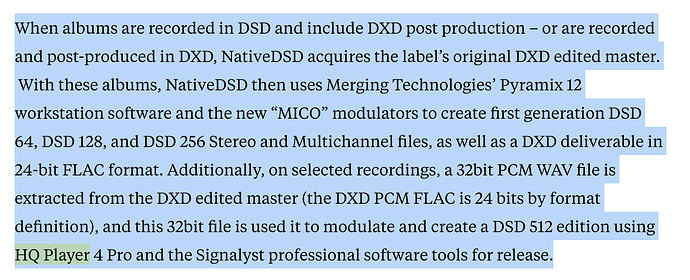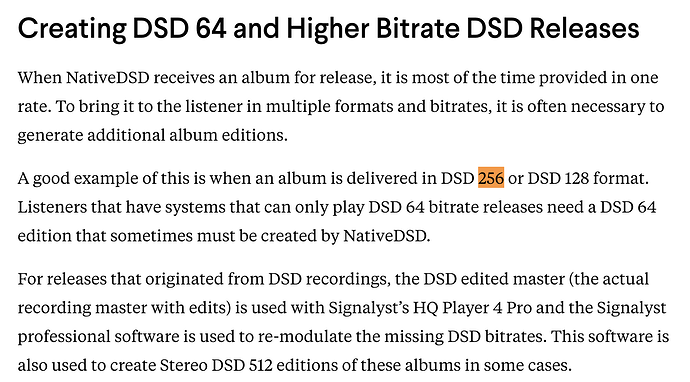Jussi has produced numerous measurements showing reduced distortion at the output end when using HQP and it’s filters.
It’s not about adding information to the source file, it’s about reproducing it more accurately, or “better”.
All digital reproduction involves filters, and every filter is a compromise. None are perfect.
HQP gives you a giant number of specially designed filters to choose from, so you can listen and see which one(s) sound best to you.
Does it totally change the sound? No. But it may give you an improvement you prefer.
Domain dsdnative.com does not exist, you meant nativedsd.com.
It is generally recommended to search for basic information about a topic before posting so it lowers the possibility that one posts a nonsense.
Producing and mastering music content is not upsampling. HQPlayer Pro was used at nativedsd.com for digital mixing and mastering in DSD domain. https://www.nativedsd.com/news/mixing-in-pure-dsd-no-pcm-allowed/
P.S.: You are of course free to create a blog on any topic, but in digital audio area … seeing your level of knowledge, I am not going to look at your blog. I would recommend you rather few years of self study instead of blogging.
Thanks for pointing out. It was my mistake.
Thanks for your comment. It is always a choice. For me, I am definitely not as expert as you guys as I am still learning. Probably you will find no new info from my blog as you know digital audio so well.
In terms of spoting pseduo science claim, applying critical thinking, I believe that I have a few things to share. My focus is on critical thinking, especially for things that are obviously wrong (similar to the mistake you pointed out earlier) ![]()
Feel free not to look at my blog ![]()
However, if you do spot anything wrong in my blog (just in case), it would be great if you can let me know about it. I would like to fix it to ensure my blog only have correct, factual info. Cheers.
My understanding is that they would create DSD512 out of DSD256 by using HQ Player based on their description below.
Am I correct?
Is DSD256=>DSD512 upsampling?
Hmm… having a second look… it may be my mistake.
Looks like they are doing:
32bit DXD (384kHz) PCM WAV ==> DSD512
The citation you used does not contain anything about them doing DSD512 out of DSD256. They describe how they produce content which has to be released both in DXD and DSD formats. They are essentially using Pyramix 12 for production. HQPlayer is used only to create DSD512 distribution format which is not supported by Pyramix. They mention creation of DSD512 format out of DXD master.
If you would use their DXD master with the same HQPlayer settings like they used to upsample to DSD512 you would of course get the same sound. Just that they will not give you their production master and their HQPlayer settings.
So HQPlayer was used only as an add on to their Pyramix based production scenario to create DSD512 distribution media. Quality of a recording is mostly influenced by recording and mixing process.
What I posted in my previous post is about how they produced DSD recordings in DSD domain with a process where PCM format was never involved. That looks more interesting. Just that available production tools are not ready to do more complex mixing this way. Such a process does not suit for typical pop music content where many instruments and voices are recorded separately in recording studio and then mixed together.
There is a lot going on in that blob of text.
DXD = 24/352.8 PCM (by definition)
DSD = 1-bit SDM (by definition)
Remember, you can’t do much with DSD on the mixing side of things so almost all recorded DSD gets converted to PCM for mixing and even if it doesn’t get converted to PCM it has to be converted to something that isn’t 1-bit SDM like 4 or 8 bit SDM (or some other exotic format). There are exceptions but this is why a lot of people just don’t bother recording in DSD.
OK, so if we need PCM to mix it… What rate do we use? and of course we need a fancy name for this optimal rate so… yeah… lets do 8x 44.1 at 24 bit… that’s kind of same resolution as DSD512 which seems all fancy with the DSD folks so, yeah, lets use that. And because 24/384 doesn’t sound nearly as fancy as DSD512 we’ll call it DXD! Marketing solved.
When converting between rates of PCM it helps to push the bit depth way up, even if it’s padded, as the maths just work better. This is why Roon goes to 64-bits. Looks like nativeDSD goes to 32 for their conversions. So, while technically “DXD”, I find the “DXD” label to be a bit meaningless anyway as it’s just 24/384… now 32/384 PCM. Yeah!
You can get a demo of HQPlayer Pro to try out. I’ve never played with it but I have been told the output is pretty fabulous as you no longer need to do things in real time which allows for longer filters than are possible in HQPlayer. That’s the advantage of converting PCM to DSD with HQPlayer Pro (or any of the other non-realtime convertors). Of course, that assumes you want to send DSD to your DAC.
*it should be noted the above is a work of opinion
An infinite filter is perfect… of course, I’m still waiting for my conversion to finish… should be any day now. ![]()
From my understading, DXD master => DSD512 is upsampling. Am I correct?
Hmm… for that I am not sure. Would they have any customization that @jussi_laako created for them exclusively? ![]()
Looks like they do (I mean the master file but not their HQPlayer settings). That’s why I was questioning if we can do the upsampling to DSD512 ourselves (as they are priced differently in nativedsd.com)
Yes, should be 352.8 (my mistake again ![]() )
)
I thought it was 768kHz vs DSD512… Hmm… I am not sure.
Yes, DXD sound very sexy. It should go well with DSD
Other than the stated benefit. My understanding is that they are the same (Pro vs Regular). If, somehow, my PC is good enough to run any filter, then is it fair to say Pro vs Regular are the same (if I only do real-time)?
You can’t directly relate DSD to PCM from how the “resolution” results into what we hear so the best we can do is just look at the multiples of the base clocks.
Since redbook is 16/44.1kHz… everything is, basically, upsampled from 44.1. And why 44.1? Because that’s what we need to meet the Nyquist-Shannon theorem so we do not lose the audible data (audible to humans that is, my dog prefers a different base clock).
So, we need a very high sampling frequency for DSD (1-bit SDM). How high? Sony and Philips picked 64 times redbook or 64x44.1kHz = 2822.4kHz. I don’t know the history how they picked that off top of my head but I think it had to do with amount of data they could store on a SACD.
OK, so… we know redbook isn’t the best for reconstruction when sending through a DAC. We also found some issues with DSD64. This is where the oversampling magic comes in… and of course what’s good on the reproduction side… why not just record at a higher rate as well?
This, eventually, is where DXD recording got us… 24/352.8 (8 times redbook)
So, if you want to identify where this might have an equivalency to DSD… I just did 8x DSD64 = 22579.2kHz or DSD512
Is it equivalent? Is that the right way to do it?
This isn’t my day job ![]()
On a side not… You can also compare PCMs frequency and dynamic range based on bit-depth and resolution and find an equivalent to DSD… DSD64 is 100kHz and 120dB were redbook 44.1kHz and somewhere 90’ish dB dynamic range. Is was this increased dynamic range that Sony / Philips marketed heavily as a benefit of SACD.
If you do some research online… You’ll find that conversion between DSD and PCM is always lossy. But, what gets lost is interesting (things like time domain).
There’s one problem there. Critical thinking (although I can’t say I’ve seen any of it in your blog) still requires knowing what you are talking about. So far, your blog is no different from a guy looking out of his window somewhere in Nebraska, and posting that the Earth is flat because he can plainly see it. Or zillions of people who “debunk” Einstein, or evolution “because I said so.”
AFAIK, nativedsd.com doesn’t have any albums recorded in DSD 512, I’m not even sure that capability exists on the pro level.
They do have albums recorded in DSD 256, DSD 128, and DSD64. All of those are converted to higher or lower rates if they are sold that way (like DSD 256 to DSD 512). They tell you on the album page what the original recording format was, and in what formats there are release versions.
They also have a small number of albums in what they call “pure DSD” - meaning it isn’t converted to PCM on the way to the master. It’s edited using a process that only converts the fraction of a second needed for the edits into PCM, the rest of the master is never converted.
Obviously most of this music is small ensembles recorded live, so no mixing is needed.
Most of their recordings are converted to DXD for mixing and mastering, and then reconverted to DSD for DSD download sales.
There are a small number of cases where they have specifically sold the actual master file. Usually these are DXD recordings that are mixed and mastered in 32/352.
They will also sell a more conventional 24/352 download of the same recording, but occasionally have released some 32/352, versions, which are the actual masters.
I don’t recall them saying they were selling actual DSD masters, but their “pure DSD” recordings sold in DSD are essentially the master if you buy the DSD download in the same rate as the recording format, which they tell you.
They can do a mix from a multi-track DSD source at any rate to any given DSD output rate in one go. Something you cannot do at your side… And yes, it does make a difference.
They operate and sample and hold principles from 352.8/384k onwards…
Let’s say you have a 32-channel DSD256 recording that you want to mix into stereo DSD512. There’s certainly benefit in doing that, since you can much better fit information content of those source channels into DSD512, than trying to reduce it into DSD256.
32 channels DSD256 → 2 channels DSD256
vs
32 channels DSD256 → 2 channels DSD512
If you want something clean, from DSD to DSD, take a look here:


